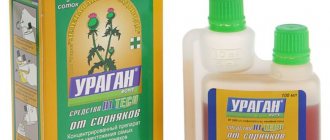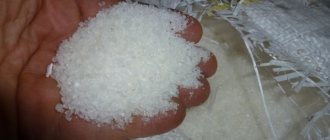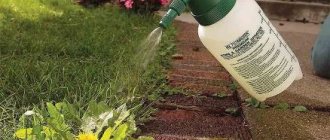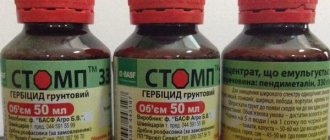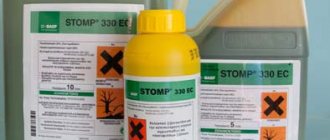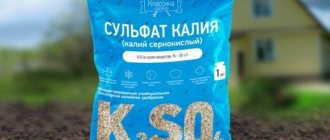Gardening » Weeds
1
486
Article rating
Kira Stoletova
Lapis lazuli is a super effective weed killer in the garden. The herbicide has a selective effect and helps fight various weeds.
Lapis lazuli is a reliable weed killer
Instructions for the drug
Lapis lazuli is a universal remedy and belongs to the group of Herbicides (chemistry).
- It is used in industrial and private cultivation of potatoes and tomatoes.
- Not suitable for beds where you plan to plant cucumbers, carrots, beets and other vegetables.
Chemical composition
The main active substance is metribuzin (70%).
It is selective in nature, selectively affecting certain weed species and not affecting cultivated plants from the nightshade family, which have a similar cellular structure of vegetative parts - stems and roots.
It is poorly soluble in liquid and remains in soil layers for up to 2 months. In some cases, it precipitates and remains in the ground for up to a year.
Release form
Available in powder form. It is packaged in bags for single use in private households of 10-20 g, for industrial purposes - in boxes and bags of 0.5-10 kg.
Cost and analogues
The price depends on the volume of packaging. Average. is 65-100 rubles.
The inexpensive drug has analogues that can be bought at the agricultural market:
- domestic - Excellent from, Miura, Lazurit-SP from the company August;
- foreign Zenkor.
Compatibility with other tools
Due to the selective action of the drug, it is advisable to use it in the preparation of tank mixtures with other herbicides, which increases the effectiveness and expands the field of action.
It is forbidden to mix the products in dry form; before combining them, the drugs must be dissolved in liquid. After thorough mixing, the prepared mixture is used for several hours for better interaction of all components. Before starting work, it is recommended to conduct a test for drug compatibility and possible phytotoxicity for the selected crop.
The drug is compatible with other similar herbicides
Impact principle
Metribuzin acts as a photosynthesis inhibitor. In the absence of this process, weeds do not develop, stop growing and die without interfering with the normal development of cultivated plants.
Attention! Lapis lazuli is not a fertilizer and does not increase productivity.
The drug has a destructive effect and destroys all vegetative parts of weeds - the root system, seeds, stems and foliage, entering plant cells through their surface.
Dried grass is removed by raking and burned.
The product simultaneously has a detrimental effect on the pathogen late blight.
It is an effective alternative to manual weeding, which often damages the root system of immature shoots and drains the soil layers.
Terms of use
Among all herbicides, lapis lazuli is the safest, but when using it you still need to take safety precautions for yourself and for the plants. When purchasing lapis lazuli herbicide, instructions for use are included in each package and must be followed strictly. But also keep in mind
- You cannot make the drug “more concentrated” - this will not improve its quality or enhance its effects.
- prepare the drug on the day of use, it should not be left the next day
- After applying the drug, do not turn over clods of earth. It is better to apply it in cloudy weather or during light rain - this way Lapis Lazuli will mix better with the soil and begin to act faster. In this case, heavy rain will wash the drug into those layers of soil where it will not act. If the weather is dry, the soil should be well watered after adding lapis lazuli.
- Be sure to use rubber gloves and do not inhale the weed killer fumes. Be sure to wear glasses. You can't eat or smoke anything. It is better to wear a protective medical mask or respirator.
- observe the time of use and its duration
- do not exceed the norms of use - this will not have a visible effect.
- The herbicide can be used at an air temperature of at least 15 degrees. At a lower level, its effectiveness decreases.
Before using herbicides, you need to keep in mind:
The potato stems must be large enough and the tubers must be deep in the ground. The drug should not affect potato sprouts.
The soil should be loose so that lapis lazuli penetrates and spreads more easily into the soil.
Advantages and disadvantages
| pros | Minuses |
| 1. Failure to comply with the standards provided for in the instructions leads to a reduction in the shelf life of vegetables and their rapid spoilage.
2. Failure to apply regularly leads to negative consequences - the accumulation of metribuzin in vegetables, which is toxic to humans. |
Application area
Due to its properties, Lapis Lazuli herbicide is effective against trace weeds. species composition:
- Amaranthaceae (field foxtail, amaranth);
- Ambrosia (all types);
- Cornflower blue;
- Veronica;
- Knotweed (species);
- Field mustard;
- cocklebur;
- Chicken millet;
- Lazornik;
- White pigweed;
- woodlouse;
- Wild oats;
- Sow thistle;
- Shepherd's Purse;
- Tares (all types);
- Purslane;
- Chamomile (unscented (pharmaceutical) and meadow chamomile);
- Blood crabgrass;
- Bristleweed (species).
Resistant to the drug:
- Field thistle;
- Field bindweed;
- Couch grass and other perennial cereal weeds;
- Nightshade black;
- Chain bedstraw;
- Eat (all types).
Rules and time
Suitable for use throughout the entire growing season.
The optimal time for treatment with Lapis Lazuli is the development phase of vegetable crops (from the moment of planting to the appearance of the first shoots) up to the 20-30-day age of the sprouts.
Weed control
This is explained by the fact that at the early stage of growth the susceptibility to the active substance is the least.
Basic Rules:
- Before use, the soil is moistened and the bushes are hilled;
- processing is carried out on a windless day;
- the optimal ambient temperature is not lower than 15°C; in cooler weather, the active component loses its effective properties;
- if there is heavy rain immediately after the procedure, it is repeated;
- the minimum dosage of the drug is used on light soils, the maximum - on heavy soils;
- The beds are sprayed with a liquid working solution immediately after its preparation, because during long-term storage it loses its effective properties;
- it is necessary to spray directly on the bush, without getting on other crops;
- Before using a herbicide, preventive procedures against pests are initially carried out, for example with Komandor.
To protect potato bushes
| Way | Time | Consumption | Dosage |
| One-time | Any time | 0.7-1.4 kg per 1 ha | 10 g per 3 liters of water |
| Double | Until the moment of germination | 500 g-1.0 kg per 1 ha | 10 g per 3 liters of water |
| Treat the hilled potato tops (no later than when the seedlings germinate 5 cm in height) | Up to 0.3 kg per 1 ha | 10 g per 9-10 liters of water |
For spraying tomatoes
| Way | Fit type | Dosage |
| One-time | Sowing seeds | up to 7 g per 10 liters of water |
| Seedling | up to 15 g per 10 liters of water | |
| Double | Sowing seeds | 1. At the stage of appearance of 2 sheets: up to 2.5 g per 10 l of water 2. When forming at least 3-5 sheets: up to 5 g per 10 l of water |
| Seedling | 1. After planting in open ground: up to 15 g per 10 liters of water 2. After 2 weeks: up to 10 g per 10 liters of water. |
Advantages
Lapis lazuli helps crops against weeds, acting as a poison for weeds, it does not pose a threat to beneficial plants. Here are some advantages of the drug:
- Low cost. Due to the low price, spending money on cultivating the land is reduced, and the yield increases.
- The drug is not able to accumulate in soil and green plants. Having completed its duration, Lapis Lazuli disappears.
- The abstract provides a guarantee for the complete destruction of weeds. The product also affects the seedlings of weeds, which will no longer grow.
- The effectiveness of the product. Metribuzin particles are completely diluted with water, so they quickly and easily enter plant tissues. The product is included both in the foliage and in the stems of the parasitic plant.
- Easy to use and dilute the solution. The prescription for the drug is written clearly, which allows even a beginner to use it.
- The versatility of the product. The user manual states that the drug targets about 50 types of weeds simultaneously. Here are some of them: ragweed, field chamomile, blue cornflower, acorn grass, quinoa, datura.
- Possibility to combine with other herbicides. Lapis lazuli does not conflict with other weed control products, so it can be alternated with them.
- Has security. This weed killer Lapis Lazuli is slightly toxic, has no irritating effect, and therefore is not dangerous for bees, has an average danger for fish, and is approved for use in fish-farming reservoirs. It does not have a negative impact on nature, as it completely decomposes in the ground within 1-3 months.
The only disadvantage can be considered that the chemical components can harm health in close contact with the human body. Therefore, the use of the drug must be carried out strictly according to the manufacturer’s instructions, taking all safety measures.
When not to use
- When the soil contains less than 1% humus;
- On plantings that have suffered from plant diseases or have suffered from frosts or have mechanical damage, through which the active ingredient can penetrate into the cellular layers;
- When cultivated plants were planted early in the garden;
- On dry soils.
For small amounts of weeds, it is recommended to limit the use of herbicides, replacing them with manual weeding and subsequent mulching.
Solution dosage
First, you should read the description of the drug. What is written there:
- The prepared solution must be used immediately to treat the area. Its effectiveness depends on this, since the delay reduces its impact.
- The remaining solution should be poured onto an unused area. Storage is not permitted.
- 20 grams of powder are used per 1 liter. For example, 6 liters will require 120 grams and so on.
To properly prepare the solution, you must continue to read the description. There are a number of steps that need to be completed:
- Shake the powder packet before use;
- The required volume of water is added to the plastic container;
- Lapis lazuli powder is poured there;
- The resulting composition is thoroughly mixed.
Spray the soil before the first shoots appear. Repeated spraying will require a different dosage. For 20 liters of water you need 20 grams of lapis lazuli.
Important: Lapis lazuli is compatible with other herbicides. Therefore, its use is allowed after treating the soil with a product of this group.
Precautionary measures
The toxicity of Lapis lazuli is low, the drug belongs to hazard class 4.
It does not harm beneficial insects, incl. bees. However, during use it is necessary to observe the following precautions:
- use personal protection, covering open areas of the skin, eyes and respiratory tract from contact with the active substance;
- do not open sealed packages during transportation;
- exclude joint storage with food, drinking water and animal feed mixtures.
Is Lapis Lazuli weed killer harmful to humans?
The drug has a hazard level of 3 (moderate). This means that when used correctly, the harm of Lapis lazuli to humans is insignificant. Exceeding the concentration, untimely treatment of crops or direct contact with the herbicide can cause significant harm to human health. Therefore, you can go to the treated areas only 3-5 days after spraying, and during work you must use protective equipment: rubber boots, gloves, thick clothing and a respirator.
Providing assistance in case of defeat
In cases of metribuzin poisoning during treatment, general signs of malaise appear: headache, sore throat, hoarse voice and dizziness.
If such symptoms are present, you should immediately stop the procedure, leave the area and provide access to fresh air.
If the solution gets on a part of the body:
- on the skin - wash off with plenty of soapy water;
- into the eyes - wash with running water at room temperature for at least 0.5 hours;
- inside - wash the stomach and drink absorbent medications.
Reviews
The herbicide Lazurit is intended for weed control. It has a selective method of action, destroys selected types of weeds without affecting the vegetative parts of cultivated plants from the nightshade family.
Actively used for tomatoes and potatoes. Requires compliance with the dosages specified in the instructions and regularity of application, because may accumulate in vegetables.
The pesticide is harmful to humans. According to customer reviews, the herbicide poison effectively copes with the protection of root crops.
